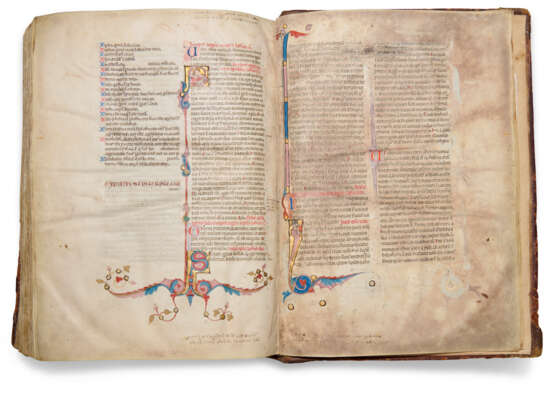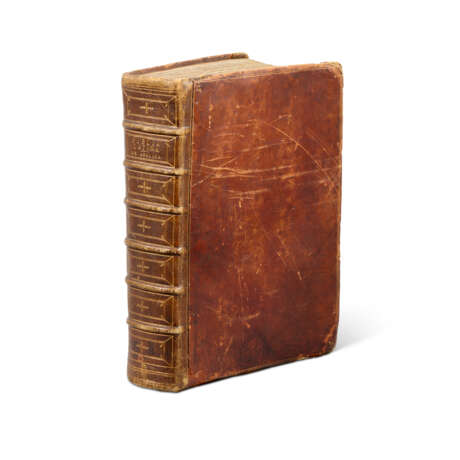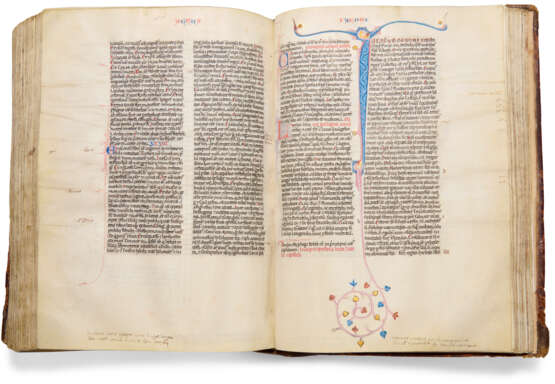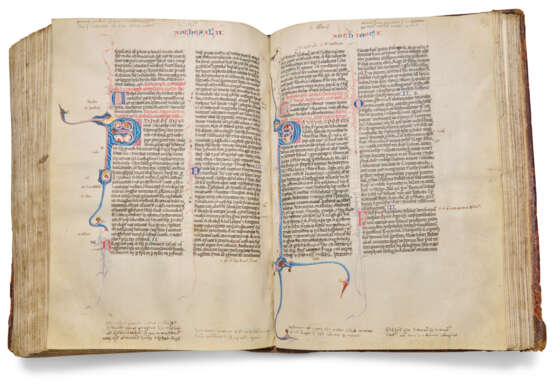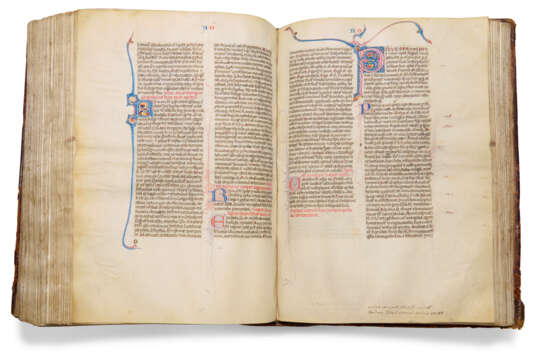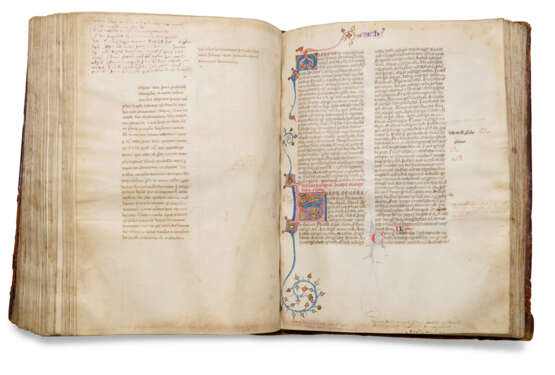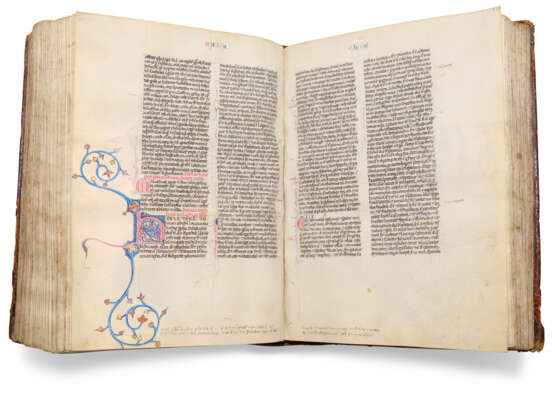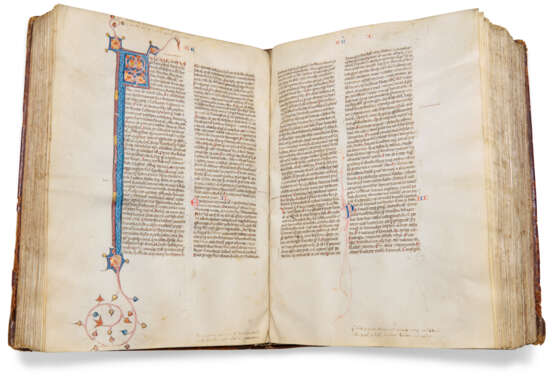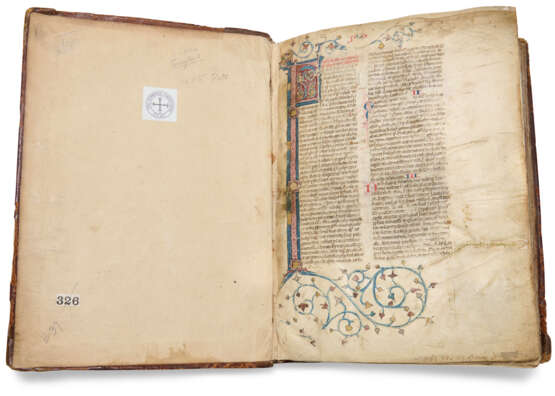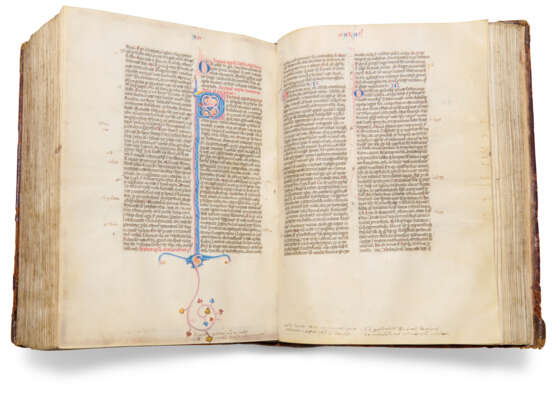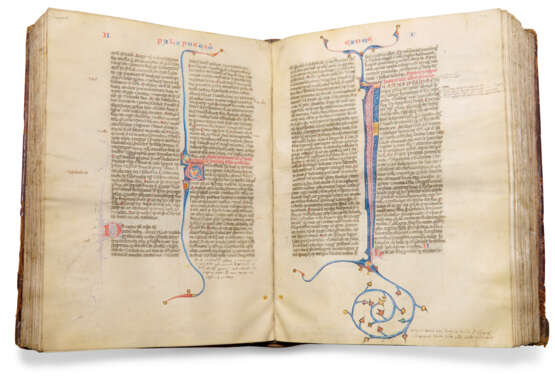ID 1214881
Lot 20 | The Gaetani Bible
Estimate value
£ 70 000 – 100 000
The Gaetani Bible: Bible with prologues and Interpretations of Hebrew Names, in Latin, illuminated manuscript on vellum
[Southern France, early 14th century]
An illuminated 'Papal' Bible likely produced in Avignon for the Gaetani family.
310 × 25mm, 500 + i leaves, including ff.224, 367-368 which were originally blank, early ink foliation, often cropped (followed here; the sporadic modern foliation in pencil in the lower margin is usually incorrect), collation: 1–1412, 1514, 16–1812, 196; 20–3112; 32–4112, 4210, in three codicological units (hence Quaritch’s description of the book as three volumes bound in one): Genesis–Psalms occupy gatherings 1-19, ending with the colophon, the rest of the old Testament occupies gatherings 20-31, and the remainder, the first two units end with blank leaves; catchwords throughout usually within a drawing of a fish (that at f.296v excised), 2 columns of 44 lines, ruled space: 190 × 145mm, chapters with two-line initials alternately red flourished in purple or blue flourished in red, approximately one hundred large illuminated initials filled with foliage and with extensions filling parts of the adjacent margins, sometimes inhabited by a lion, dragon, etc., or with a bird-head, at the beginnings of the biblical books, some prologues, some divisions of the Psalms, historiated initials by a different illuminator on the final leaves, the margins with an unusually large number of medieval notes, written by more than one hand, some subsequently erased (generally in good condition with wide margins, but with thumbing and minor defects, and stains to some margins). Sewn on six bands and bound in diced brown russia leather over pasteboards, the covers framed by a double gilt fillet and with a gilt acorn stamp in each corner, the edges of the leaves speckled red, rebacked in the 19th century with a title in gilt capitals ‘Biblia / Latina. / MS. Anglica.’ (scuffed, the corners worn).
Provenance:
(1) Signed by the scribe Philippe/Filippo at the end of the Psalms, in a three-line rhyming verse colophon: ‘Finito libro referamus gratias Christo / Qui scripsit scribat semper cum domino vivat. / Vivat in celis Phylippus nomine felix’ (quoted from this manuscript in Colophons de manuscrits occidentaux, V (Fribourg, 1979), no 16,046, and J.W. Bradley, A Dictionary of Miniaturists, Illuminators, Calligraphers, and Copyists, III (London, 1889), p.65). Perhaps written for a member of the Gaetani family who wanted to emphasise his family connection to the papacy (see Illumination).
(2) Unidentified monastic owner, who added marginal notes of the days when biblical passages were read in the Divine Office, e.g. ‘Feria va’, ‘Feria vj’, ‘Sabb(at)o’, ‘Do(minic)a i(n) xla [i.e. Quadragesima Sunday]’, ‘Feria ij’, ‘Feria iij’ (ff.50v, 52v, 54, 56, 59, 60, respectively), and others.
(3) Inscribed at the top and bottom of the first page, apparently with the name of a priest (‘presbyteri’ is legible).
(4) John Kendall (1726–1815), English Quaker minister and writer (on whom see the ODNB); bequeathed by him to the Friends’ (i.e Quaker) School at Colchester; sold by them fifty years later at Sotheby’s, Catalogue of the valuable collection […] bequeathed by John Kendall […], 9 March 1865, lot 353; bought by Ellis for £20 5s.
(5) Bernard Quaritch, Catalogue 88: Choice Portions Selected from Various Minor Libraries (1888), no 652; and A Catalogue of Bibles, Liturgies, Church History, and Theology (December 1891), no 89.
(6) Thomas Thorp, bookseller of Guilford: his Catalogue 178 (1935), no 761, priced £63; doubtless sold by him at Sotheby's 19 May 1936, lot 9, bought by Marks (i.e. Marks & Co., 84 Charing Cross Rd.), for £25, doubtless (see lot 25) on behalf of:
(7) Dawson’s Book Shop, Los Angeles: included in their Catalogue 120 (May 1937), no 44, priced $350; bought by:
(8) Otto F. Ege, Cleveland, Ohio (1888–1951) (S. Gwara, Otto Ege’s Manuscripts (2013), Handlist 130); sold by his heirs at Sotheby's 11 December 1984, lot 41 (with full-page plate), bought by ‘Percival’.
(9) Dörling, Hamburg, Auktion 132: Wertvolle Bücher, Manuskripte und Autographen, 29 November 1989, lot 8 (the back pastedown inscribed ‘cxxxii/8’).
(10) Sam Fogg, London; acquired from him in June 1990 by:
(11) The Schøyen Collection, MS 661.
Content:
The biblical books and prologues have significant differences from the common ‘Paris’ order and selection: e.g. Joshua has an extra prologue; Psalms has two prologues and is followed by twelve lines of verse: ‘Psallere qui docuit dulci modulamine sanctos […]’ (printed by de Bruyne, Préfaces de la Bible latine, 1920, p. 66, as ‘Versiculi Hieronymi presbyteri’), and the colophon (see Provenance), plus an added list of the six ferial Canticles and the Benedictus; Proverbs has an extra prologue; Ecclesiasticus has the Prayer of Solomon, and Wisdom is between Ecclesiastes and the Song of Songs; Isaiah has an extra prologue; Lamentations 5 has an illuminated initial and heading ‘Oratio Ieremie’, followed by the prologue to Baruch but not Baruch itself, it being found between the Prophets and Maccabees; Maccabees is followed by a lengthy addition beginning ‘[S]ecundum Augustinus in primo libro super Genesim ad litteram capitulo 1, Sacra scriptura canonis habet duas partes principales, scilicet novum testamentum et vetus, sive legem veterem et novam […]’; the Gospels have marginal cross references to one another; before James are two misplaced prologues followed by a note saying that they ought to be before Acts; the Interpretations of Hebrew Names, Aaz–Zuzim, are followed by the addition of 2–3 John, Jude, and the prologue to the Apocalypse which had all been accidentally omitted after 1 John; these latter must be a slightly later addition as their illumination is different from the rest.
Under many columns of text there is a two-line summary, added in a cursive hand. The gospels have marginal cross-references to one or more of the other gospels, or ‘solus’, presumably indicating that the passage occurs in the current gospel only. The cross-references are numbered consecutively in red arabic numerals, the numbers reaching 355 in Matthew, 234 in Mark, 343 in in Luke, and 232 in John.
Illumination:
The manuscript has almost always been described in the past as Italian (with Naples and Pisa offered as possible places of origin), but the styles of both minor decoration (with mauve penwork) and major illumination suggest instead that it is instead from southern France, where Italian influence was often strong, especially at Avignon from 1309 onwards when the papacy – and Italian scribes and illuminators – were based there. As the bookseller Thorp perceptively noted in 1935, ‘The script of this manuscript is Italian in style […] but the decoration is definitely French in character, hence the conclusion that it is the product of one of the southern provinces of France’.
The texts which were accidentally omitted and then added at the end (ff.498v–500) were illuminated by a different artist who also appears to be southern French, including three figural initials:
1. 2 John: St John, half-length, holding a scroll.
2. Jude: A creature with a human upper body, holding a book, but with a head like a cat(?) with a tonsure.
3. Prologue to the Apocalypse: a human-headed wading-bird stands on the initial.
The Genesis initial extends the full height of the text, and has scrolling foliate extensions forming partial borders in the upper and lower margins; the body of the initial with twenty-two polygons with backgrounds alternately blue or pink, the top one and every third thereafter with a heraldic shield, as follows:
1. Gules, a cross sable (or tarnished argent?), a key of the same in each quarter, their wards downwards and outwards; previously identified as ‘the arms of the Church or the Papacy.’
2. Or, the charges indistinct.
3. Or, three bars gules: the arms of Pope Clement V (1305–1314), who was responsible for moving the Papacy from Rome to Avignon.
4. Or, an uncertain charge in each quarter, azure.
5. Or, three palets gules, as used by the da Vinci family of Tuscany (and later by Pope Benedict XIV).
6. Or, two bends nebuly azure: Gaetani, as used by Benedetto Caetani, who became Pope Boniface VIII (1294–1303).
7. Quarterly, 1 and 4 argent, 2 and 3 gules, impaled with: Or, three bars gules: Gaetani of Pisa and Sicily.
8. Chequy, or and azure, a chief gules.
Although the first shield has not been identified, it is plausible that it relates to the papacy (one of whose primary emblems are the keys of St Peter), especially in light to the fact that two of the other shields were borne by early 14th century popes. One of these popes was a member of the Gaetani/Caetani family, another branch of which used the arms in the 7th shield.
| Place of origin: | Italy, Europe |
|---|---|
| Auction house category: | Medieval & renaissance manuscripts, Books and manuscripts |
| Place of origin: | Italy, Europe |
|---|---|
| Auction house category: | Medieval & renaissance manuscripts, Books and manuscripts |
| Address of auction |
CHRISTIE'S 8 King Street, St. James's SW1Y 6QT London United Kingdom | |
|---|---|---|
| Preview |
| |
| Phone | +44 (0)20 7839 9060 | |
| Buyer Premium | see on Website | |
| Conditions of purchase | Conditions of purchase |
